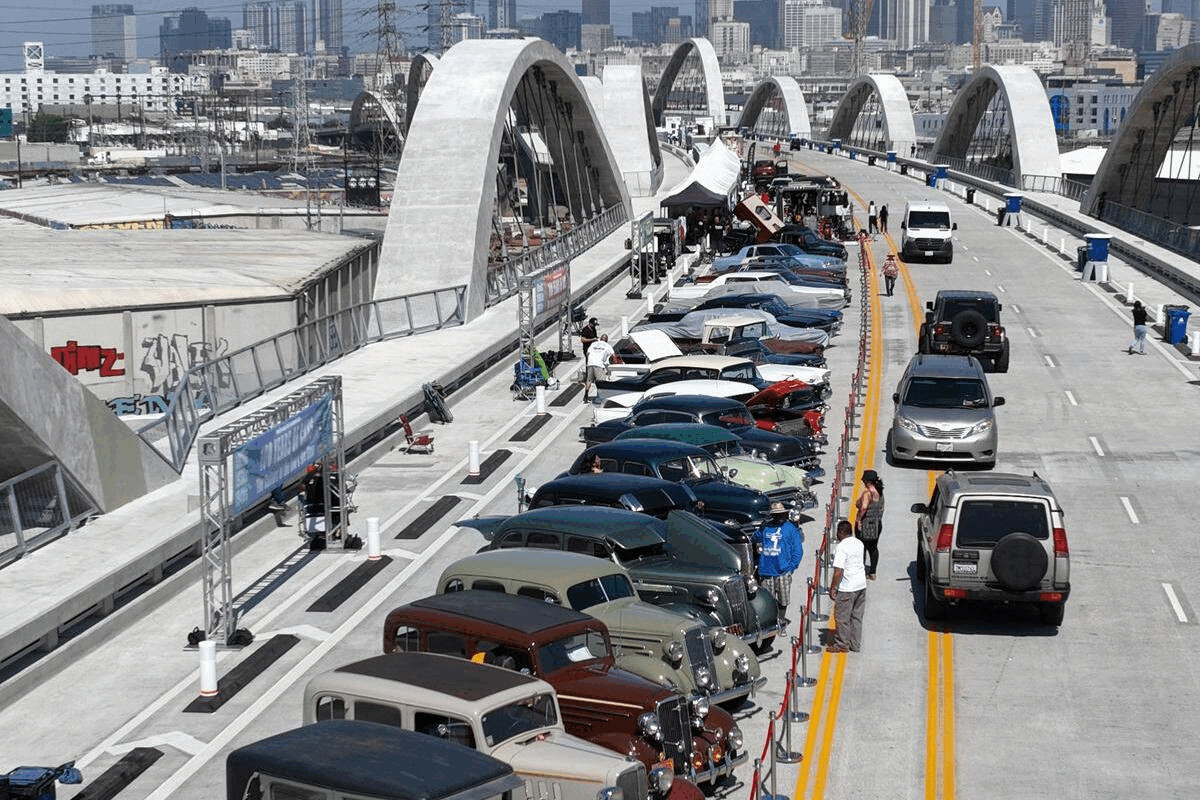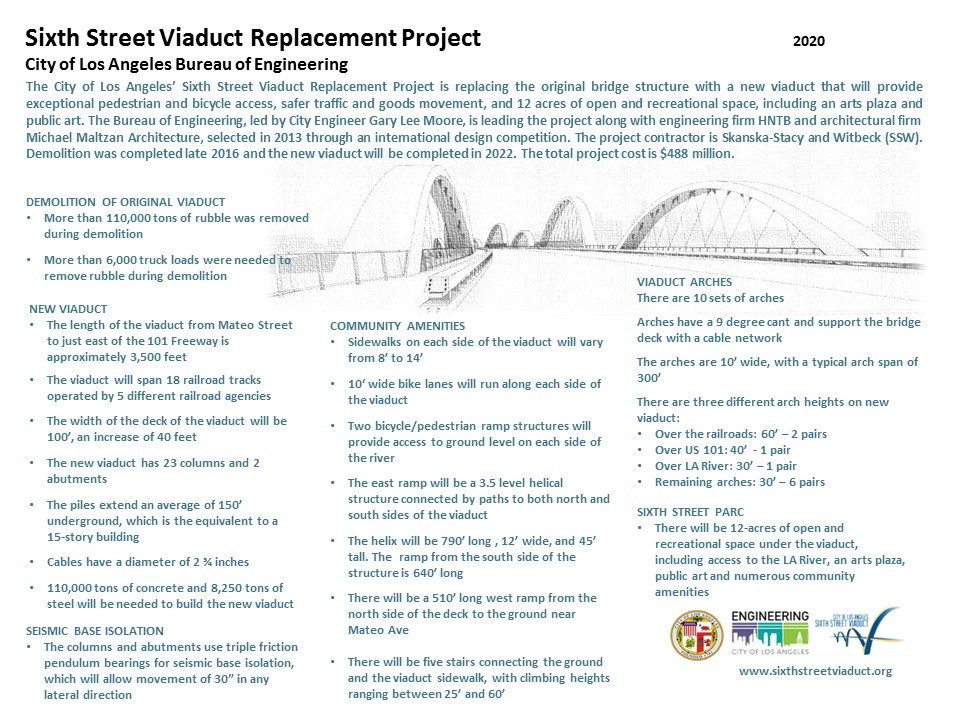Completed in July 2022, the transformative Sixth Street Viaduct stands as a testament to modern engineering and architectural vision in Los Angeles. This ambitious $588 million project, managed by the City of Los Angeles Bureau of Engineering, marks the largest bridge endeavor in the city’s history, replacing a beloved but aging landmark with a structure designed for the future.
From Deterioration to Design Competition: The Genesis of the New Viaduct
The original Sixth Street Viaduct, dating back to 1932, had served Los Angeles faithfully for decades. However, time and an inherent flaw in its concrete composition took their toll. Alkali Silica Reaction (ASR), a condition where concrete aggregate reacts with moisture causing internal cracking and weakening, plagued the bridge. Despite numerous attempts to retrofit and preserve the original structure, it became clear that replacement was the only viable long-term solution.
Recognizing the significance of this vital artery connecting the Arts District and Boyle Heights, the Bureau of Engineering initiated an international design competition in 2012. Extensive community outreach and consultation informed the process, ensuring the new viaduct would not only be functional but also aesthetically resonant. The winning design, dubbed “The Ribbon of Light,” emerged from the collaboration of local Los Angeles firm Michael Maltzan Architects and HNTB, promising a structure as iconic as its predecessor, yet thoroughly modern.
Demolition of the old viaduct commenced in 2016, a nine-month undertaking that paved the way for construction of its successor. Funding for this massive project came from a combination of sources, including the Federal Highway Administration, the California Department of Transportation, and the City of Los Angeles, underscoring the importance of the Sixth Street Viaduct on a local and national scale.
Features of the Sixth Street Viaduct: More Than Just a Bridge
The new Sixth Street Viaduct is far more than a simple replacement; it’s an upgrade in every sense. Beyond its ten sets of color-changing LED-lit arches that illuminate the Los Angeles skyline, the viaduct incorporates a wealth of features designed for modern urban life:
- Expansive Sidewalks: Pedestrians are catered to with sidewalks ranging from 8 to 14 feet wide on each side, encouraging walking and offering stunning city views.
- Protected Bike Lanes: Cyclists benefit from dedicated 10-foot wide Class IV protected bike lanes along both sides of the viaduct, promoting cycling as a safe and viable transportation option.
- Helical Ramps: Innovative ramp designs enhance connectivity. The east ramp in Boyle Heights is a 3.5-level helical structure seamlessly linking to both the north and south sides of the viaduct. This ramp stretches 790 feet in length, is 12 feet wide, and reaches a height of 45 feet. A 510-foot long west ramp on the north side provides ground access near Mateo Street.
- Stairway Access to Future Park: Five sets of stairs are integrated into the design, providing access to the ground below. These will become even more significant when the planned Sixth Street Viaduct PARC (Park, Arts, River, Connectivity) is completed in 2026, promising to integrate green space and recreational amenities beneath the bridge.
 Crowds celebrate the grand opening of the Sixth Street Viaduct in Los Angeles, July 2022
Crowds celebrate the grand opening of the Sixth Street Viaduct in Los Angeles, July 2022
Honoring the Past: The Legacy of the Original Sixth Street Viaduct
While embracing the future, the new Sixth Street Viaduct also acknowledges its past. The original 1932 bridge was an engineering marvel in its own right, the longest of fourteen historic bridges spanning the Los Angeles River. It served as a crucial link between communities and became a cultural icon, frequently featured in Hollywood films, music videos, and commercials, often symbolizing the raw, urban character of Los Angeles.
Spanning 3,500 feet, the original viaduct accommodated a four-lane roadway and sidewalks. Its construction was notable for utilizing an on-site concrete mixing plant, a unique approach compared to other river bridges of the time. Despite its initial grandeur and importance, the seeds of its demise were sown within its concrete mix, leading to the Alkali Silica Reaction that would ultimately necessitate its replacement. Decades of restoration attempts proved futile, and seismic vulnerability studies further highlighted the urgent need for a new structure.
The Sixth Street Viaduct Replacement Project: A Citywide Effort
Under the leadership of City Engineer Gary Lee Moore, the Sixth Street Viaduct Replacement Project was a collaborative effort involving the Bureau of Engineering and the Bureau of Contract Administration. The $588 million investment reflects the project’s scale and importance. The design by Michael Maltzan Architects and HNTB, executed by contractors Skanska Stacy and Witbeck, was the culmination of an international design competition, ensuring world-class architectural and engineering expertise.
Beyond its infrastructural impact, the project also generated hundreds of jobs, providing a significant economic boost to central Los Angeles and surrounding neighborhoods during its construction phase.
 Design fact sheet graphic showcasing key features of the Sixth Street Viaduct replacement project in Los Angeles
Design fact sheet graphic showcasing key features of the Sixth Street Viaduct replacement project in Los Angeles
Community and Design Collaboration: Shaping the “Ribbon of Light”
The design of the Sixth Street Viaduct was not conceived in isolation. Two key committees played vital roles in shaping the project: the Design Aesthetic Advisory Committee (DAAC) and the Community Advisory Committee (CAC).
The DAAC, appointed by the former Mayor, comprised community leaders and professionals who provided input on the bridge’s aesthetics, including colors, textures, lighting, and monumental elements. Their expertise ensured the “Ribbon of Light” would be visually striking and contextually appropriate.
The CAC, representing a diverse cross-section of community stakeholders, advised the Bureau of Engineering during the Environmental Impact Report and planning phases. This committee addressed community concerns, fostered public involvement in the design process, and helped build community ownership and consensus regarding the new viaduct’s design, recreational features, and safety aspects.
 Diagram illustrating the structural components and layout of the Sixth Street Viaduct in Los Angeles
Diagram illustrating the structural components and layout of the Sixth Street Viaduct in Los Angeles
Arches of Innovation: Engineering the Icon
The ten pairs of arches are a defining feature of the Sixth Street Viaduct. These arches, canted outwards at a 9-degree angle, support the bridge deck using a network of robust 2 3/4″ diameter cables. Each arch is 10 feet wide with a typical span of 300 feet. Varying arch heights add visual dynamism to the structure:
- 60 feet: 2 pairs over the railroad tracks.
- 40 feet: 1 pair over US 101.
- 30 feet: 7 remaining pairs.
“Bridging Los Angeles”: Documenting the Transformation
The Bureau of Engineering produced a documentary, “Bridging Los Angeles,” capturing the story of the Sixth Street Viaduct and other historic bridges along the Los Angeles River. This film, screened publicly in January 2016, offers a deeper look into the history and significance of these vital structures. The documentary can be viewed online, providing further context and appreciation for the Sixth Street Viaduct project.
For those interested in capturing the viaduct on film, all filming requests are managed by FilmLA, the official film permit agency for the City of Los Angeles.
The Sixth Street Viaduct stands as a symbol of Los Angeles’s commitment to progress, innovation, and community engagement. More than just a bridge, it’s a vibrant public space, an architectural statement, and a testament to the city’s enduring spirit. As the “Ribbon of Light” illuminates the Los Angeles skyline, it marks not just a replacement, but a reimagining of a vital urban artery for generations to come.
